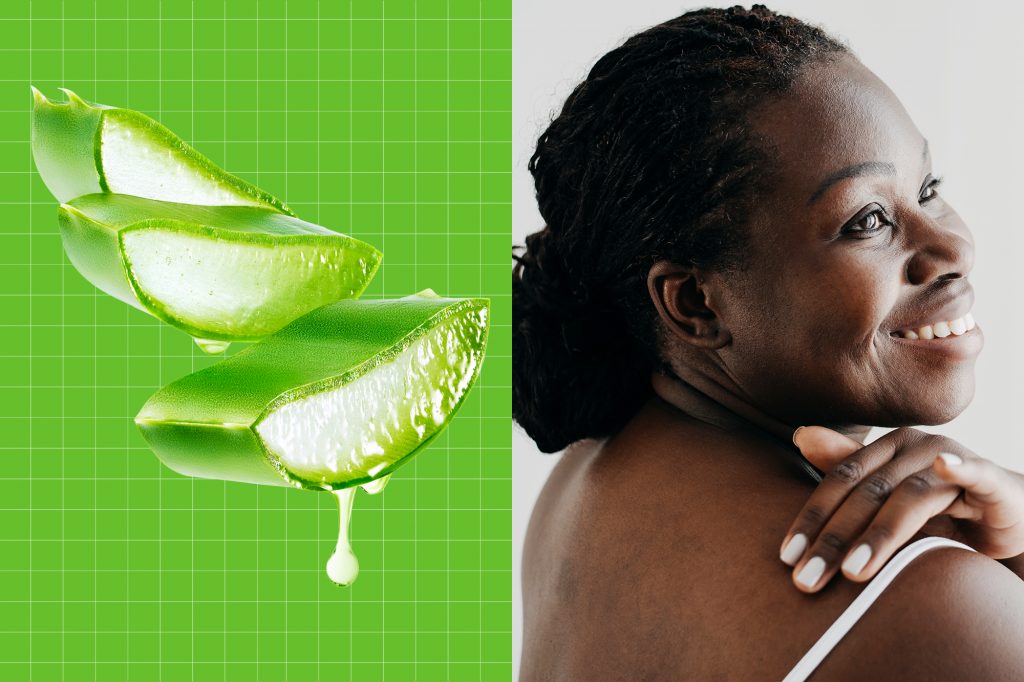6 Benefits of Aloe for Skin, According to Dermatologists

The benefits of aloe go way beyond treating a sunburn!
When you spot a bottle of aloe vera gel, chances are you have flashes of scorched skin after too much time in the sun (and research shows it can benefit sunburn). But aloe’s benefits for skin span much wider than that, so it may be time to broaden its role in your beauty regimen.
Aloe vera is a gel-like substance obtained from aloe, which is a succulent plant that typically grows in hot, dry climates. New York-based cosmetic dermatologist Michele Green, M.D., says, “It has antioxidant, antibacterial and anti-inflammatory properties that boost healing, moisturize the skin and prevent aging.”
Research suggests aloe plants might be home to up to 200 different active compounds, such as vitamins, minerals and amino acids, that can help treat a variety of skin conditions, like minor burns, psoriasis and seborrheic dermatitis.
More studies are needed to fully support aloe’s benefits for skin, though: “Not all studies have demonstrated a benefit, so although aloe vera is likely safe to try, we don’t yet have the large, rigorous studies relied on in medicine to make specific recommendations,” says Lauren Taglia, M.D., Ph.D., , a dermatologist at Northwestern Medicine Central DuPage Hospital in Winfield, Illinois.
Aloe vera does contain well-studied vitamins and minerals, like vitamins C and E and zinc, so the current theory is aloe vera might not correct skin issues by itself, but could enhance what you’re already doing for your skin when applied in tandem with other products.
Here are just some of the ways aloe vera’s skin benefits might enhance your current skin-care routine, according to dermatologists:
Benefits of Aloe Vera for Skin
1. Soothing Sunburns and Skin Injuries
“Aloe vera soothes sunburns and skin injuries by increasing collagen synthesis and cross-linking. This helps reduce any resulting scar tissue and speeds up wound healing,” says Green. Aloe also contains compounds called aloin and anthraquinones, which have anti-inflammatory and antioxidant benefits that can help alleviate pain and promote healing.
But take heed: Aloe vera should only be applied to mild-to-moderate first- and second-degree burns—more severe burns need to be treated in a medical facility, says Green.
2. Moisturizing Skin
Since aloe vera contains humectants (substances that attract water from the air or from deeper in the skin), it’s thought to be especially beneficial for dry skin types. “Aloe specifically contains mucopolysaccharides, which bind moisture into the skin,” says Green. “It also has cohesive effects by sticking together flaking epidermal skin cells, resulting in softer skin and improved skin integrity.”
3. Fading Dark Spots and Stretch Marks
There are two compounds in aloe that may fade dark spots and stretch marks: aloesin and aloin, says Green. In one study, aloesin was applied four times per day for 15 days and was found to be effective in treating UV-induced and post-acne hyperpigmentation. Another study found aloin destroyed melanin cells (an overproduction of which causes dark spots to form) in pigmented cells by blocking activity of tyrosinase, an enzyme responsible for melanin production.
4. Managing Acne
Aloe vera contains naturally occurring salicylic acid, urea nitrogen, cinnamic acid, phenols and sulfur—all of which inhibit the growth of fungi, bacteria and viruses. “It also has anti-inflammatory capabilities, which suppresses P. acnes, the bacteria that causes acne,” says Green. “Salicylic acid is currently one of the best ways to prevent acne, since it sheds dead cells from the outer layer of the skin and decreases redness and inflammation,” she adds.
5. Soothing Skin Conditions
Flare-ups of psoriasis—an inflammatory condition that causes red, itchy and scaly patches—may be better managed with aloe vera in the mix, thanks to its anti-inflammatory properties. Ditto eczema, a skin condition that causes your skin to become red and itchy and more prone to fungal and bacterial infections: “Aloe has antiseptic, antibacterial, anti-fungal and anti-inflammatory properties that may soothe eczema by hydrating and protecting it from contaminants,” says Green.
6. Slowing Signs of Aging
Because aloe vera contains vitamins C and E, it stands to reason it may help prevent the formation of free radicals, which are the molecules that cause cell damage. Meanwhile, the salicylic acid it contains acts as a gentle exfoliant—and once those pesky dead skin cells are out of the way, your other skin-care products might better penetrate the surface and do their thing more effectively as a result.
How to Choose the Best Aloe Vera Gel for Your Skin
To score as many potential aloe vera skin benefits as possible, it’s best to purchase pure aloe vera gel, rather than a formulated product, where the amount of aloe may be very little. “Unfortunately, products don’t list the concentrations of active ingredients,” says Taglia. (But if aloe vera is found within the first three ingredients on the list, this suggests there’s a promising amount in the formulation.)
Because some preservation is necessary, there’s no such thing as 100% aloe vera gel, so try to find one that has the highest percentage of aloe vera—it should be first on the ingredients list—and the least number of additional ingredients possible. (FYI: If the label says 100% gel, that means it’s pure gel, not pure aloe vera.)
It’s also important the aloe vera gel not contain additives, like alcohol, fragrance or colour (aloe vera should be clear, not green), as these additives can be irritating to the skin and defeat the purpose.
For original article: https://www.eatingwell.com/article/7951954/benefits-of-aloe-vera-for-skin/